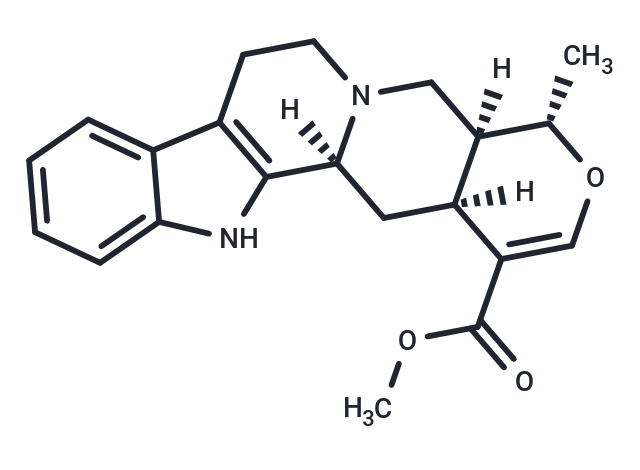Shopping Cart
- Remove All
 Your shopping cart is currently empty
Your shopping cart is currently empty

Tetrahydroalstonine is an indole alkaloid extracted from the fruit of Rhazya stricta and is a selective α2-adrenoceptor antagonist. tetrahydroalstonine has shown antipsychotic activity in Rauwolfia tetraphylla.

| Pack Size | Price | Availability | Quantity |
|---|---|---|---|
| 5 mg | $569 | 7-10 days | |
| 1 mL x 10 mM (in DMSO) | $442 | 7-10 days |
| Description | Tetrahydroalstonine is an indole alkaloid extracted from the fruit of Rhazya stricta and is a selective α2-adrenoceptor antagonist. tetrahydroalstonine has shown antipsychotic activity in Rauwolfia tetraphylla. |
| In vivo | The tetrahydroalstonine (0.5 to 2 mg/kg) on alpha 1- and alpha 2-adrenoceptors were assessed by effects on the rise in blood pressure induced by stimulation of the sympathetic outflow from the spinal cord or by injection of noradrenaline in pithed rats. Tetrahydroalstonine antagonized the effects of injected noradrenaline. Tetrahydroalstonine is more selective for alpha 2-adrenoceptors.[2] |
| Molecular Weight | 352.43 |
| Formula | C21H24N2O3 |
| Cas No. | 6474-90-4 |
| Smiles | [H][C@@]12C[C@]3([H])C(=CO[C@@H](C)[C@]3([H])CN1CCc1c2[nH]c2ccccc12)C(=O)OC |
| Relative Density. | 1.3 g/cm3 |
| Storage | store at low temperature | Powder: -20°C for 3 years | In solvent: -80°C for 1 year | Shipping with blue ice. | |||||||||||||||||||||||||||||||||||
| Solubility Information | DMSO: 90.0 mg/mL (255.4 mM ), Sonication is recommended. | |||||||||||||||||||||||||||||||||||
Solution Preparation Table | ||||||||||||||||||||||||||||||||||||
DMSO
| ||||||||||||||||||||||||||||||||||||

Copyright © 2015-2024 TargetMol Chemicals Inc. All Rights Reserved.